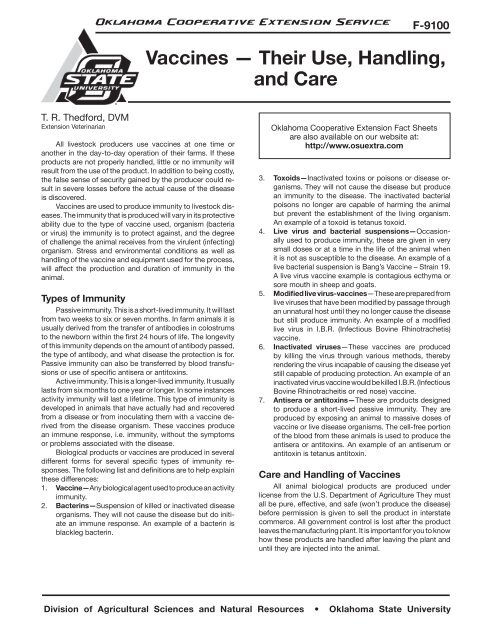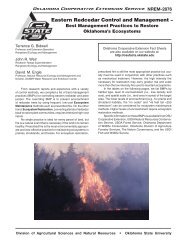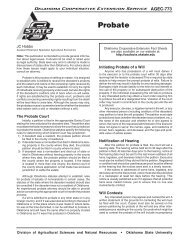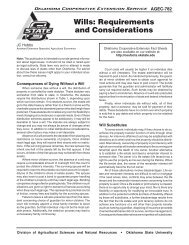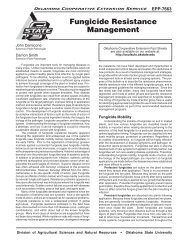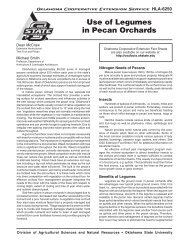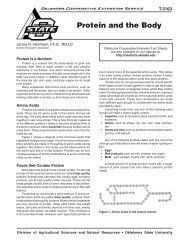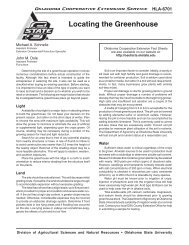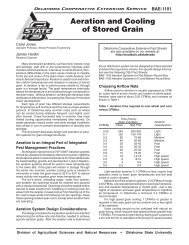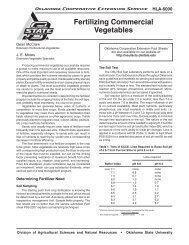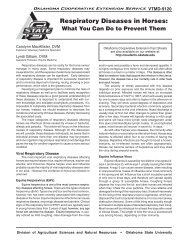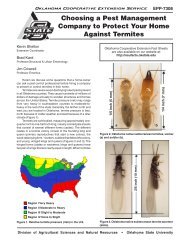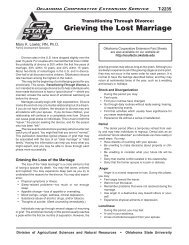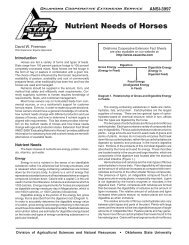Their Use, Handling, and Care - OSU Fact Sheets - Oklahoma State ...
Their Use, Handling, and Care - OSU Fact Sheets - Oklahoma State ...
Their Use, Handling, and Care - OSU Fact Sheets - Oklahoma State ...
You also want an ePaper? Increase the reach of your titles
YUMPU automatically turns print PDFs into web optimized ePapers that Google loves.
<strong>Oklahoma</strong> Cooperative Extension Service<br />
F-9100<br />
Vaccines — <strong>Their</strong> <strong>Use</strong>, <strong>H<strong>and</strong>ling</strong>,<br />
<strong>and</strong> <strong>Care</strong><br />
T. R. Thedford, DVM<br />
Extension Veterinarian<br />
All livestock producers use vaccines at one time or<br />
another in the day-to-day operation of their farms. If these<br />
products are not properly h<strong>and</strong>led, little or no immunity will<br />
result from the use of the product. In addition to being costly,<br />
the false sense of security gained by the producer could result<br />
in severe losses before the actual cause of the disease<br />
is discovered.<br />
Vaccines are used to produce immunity to livestock diseases.<br />
The immunity that is produced will vary in its protective<br />
ability due to the type of vaccine used, organism (bacteria<br />
or virus) the immunity is to protect against, <strong>and</strong> the degree<br />
of challenge the animal receives from the virulent (infecting)<br />
organism. Stress <strong>and</strong> environmental conditions as well as<br />
h<strong>and</strong>ling of the vaccine <strong>and</strong> equipment used for the process,<br />
will affect the production <strong>and</strong> duration of immunity in the<br />
animal.<br />
Types of Immunity<br />
Passive immunity. This is a short-lived immunity. It will last<br />
from two weeks to six or seven months. In farm animals it is<br />
usually derived from the transfer of antibodies in colostrums<br />
to the newborn within the first 24 hours of life. The longevity<br />
of this immunity depends on the amount of antibody passed,<br />
the type of antibody, <strong>and</strong> what disease the protection is for.<br />
Passive immunity can also be transferred by blood transfusions<br />
or use of specific antisera or antitoxins.<br />
Active immunity. This is a longer-lived immunity. It usually<br />
lasts from six months to one year or longer. In some instances<br />
activity immunity will last a lifetime. This type of immunity is<br />
developed in animals that have actually had <strong>and</strong> recovered<br />
from a disease or from inoculating them with a vaccine derived<br />
from the disease organism. These vaccines produce<br />
an immune response, i.e. immunity, without the symptoms<br />
or problems associated with the disease.<br />
Biological products or vaccines are produced in several<br />
different forms for several specific types of immunity responses.<br />
The following list <strong>and</strong> definitions are to help explain<br />
these differences:<br />
1. Vaccine—Any biological agent used to produce an activity<br />
immunity.<br />
2. Bacterins—Suspension of killed or inactivated disease<br />
organisms. They will not cause the disease but do initiate<br />
an immune response. An example of a bacterin is<br />
blackleg bacterin.<br />
<strong>Oklahoma</strong> Cooperative Extension <strong>Fact</strong> <strong>Sheets</strong><br />
are also available on our website at:<br />
http://www.osuextra.com<br />
3. Toxoids—Inactivated toxins or poisons or disease organisms.<br />
They will not cause the disease but produce<br />
an immunity to the disease. The inactivated bacterial<br />
poisons no longer are capable of harming the animal<br />
but prevent the establishment of the living organism.<br />
An example of a toxoid is tetanus toxoid.<br />
4. Live virus <strong>and</strong> bacterial suspensions—Occasionally<br />
used to produce immunity, these are given in very<br />
small doses or at a time in the life of the animal when<br />
it is not as susceptible to the disease. An example of a<br />
live bacterial suspension is Bang’s Vaccine – Strain 19.<br />
A live virus vaccine example is contagious ecthyma or<br />
sore mouth in sheep <strong>and</strong> goats.<br />
5. Modified live virus-vaccines—These are prepared from<br />
live viruses that have been modified by passage through<br />
an unnatural host until they no longer cause the disease<br />
but still produce immunity. An example of a modified<br />
live virus in I.B.R. (Infectious Bovine Rhinotrachetis)<br />
vaccine.<br />
6. Inactivated viruses—These vaccines are produced<br />
by killing the virus through various methods, thereby<br />
rendering the virus incapable of causing the disease yet<br />
still capable of producing protection. An example of an<br />
inactivated virus vaccine would be killed I.B.R. (Infectious<br />
Bovine Rhinotracheitis or red nose) vaccine.<br />
7. Antisera or antitoxins—These are products designed<br />
to produce a short-lived passive immunity. They are<br />
produced by exposing an animal to massive doses of<br />
vaccine or live disease organisms. The cell-free portion<br />
of the blood from these animals is used to produce the<br />
antisera or antitoxins. An example of an antiserum or<br />
antitoxin is tetanus antitoxin.<br />
<strong>Care</strong> <strong>and</strong> <strong>H<strong>and</strong>ling</strong> of Vaccines<br />
All animal biological products are produced under<br />
license from the U.S. Department of Agriculture They must<br />
all be pure, effective, <strong>and</strong> safe (won’t produce the disease)<br />
before permission is given to sell the product in interstate<br />
commerce. All government control is lost after the product<br />
leaves the manufacturing plant. It is important for you to know<br />
how these products are h<strong>and</strong>led after leaving the plant <strong>and</strong><br />
until they are injected into the animal.<br />
Division of Agricultural Sciences <strong>and</strong> Natural Resources • <strong>Oklahoma</strong> <strong>State</strong> University
1. All biologicals should be shipped in a cool <strong>and</strong> well-insulated<br />
container. They should be stored in a refrigerator.<br />
2. Lyophilized dry products should not be mixed until ready<br />
to be used. These products come in two containers, one<br />
containing a small dry power or cake, the other, a liquid.<br />
Do not mix more than what will be used in one hour<br />
maximum. Never keep mixed portions, even until the<br />
next day, as all of these products lose their immunizing<br />
properties after a few hours of being mixed.<br />
3. Always observe the expiration date printed on the bottle.<br />
If the product has expired, do not use it.<br />
4. Never allow biologicals to sit in the sun before or after<br />
being mixed. Sunlight will destroy as well as heat the<br />
product. Maintain your biological products in a cooler<br />
chest with frozen water-filled cans. This will keep them<br />
cool as well as keep them out of the direct sunlight.<br />
5. Do not save parts of vials. If using a multiple dose container,<br />
never enter the container with a needle that isn’t<br />
sterile.<br />
6. Never use syringes <strong>and</strong> needles that have been sterilized<br />
in chemical disinfectants. Sterilize all syringes <strong>and</strong><br />
needles used for vaccines by boiling in distilled water for<br />
20 minutes. Chemical disinfectants will destroy modified<br />
live <strong>and</strong> live biologicals. Do not waste the effort of<br />
livestock h<strong>and</strong>ling <strong>and</strong> the cost of vaccine by trying<br />
to clean equipment in alcohol or some other chemical<br />
disinfectant.<br />
7. Always burn or otherwise destroy vaccine bottles. Do<br />
not leave them lying around as a hazard to man <strong>and</strong><br />
animal.<br />
8. Be as clean as possible with the inoculation procedure.<br />
This doesn’t mean efficiency need be sacrificed. Keep<br />
an adequate supply of clean, sterilized needles available<br />
<strong>and</strong> change when one becomes contaminated. It<br />
is a good idea to change needles about every five to 10<br />
cows if anaplasmosis is a problem in your area.<br />
9. Always give biologicals according to the manufacturer’s<br />
directions. Intramuscular means in the muscle <strong>and</strong> should<br />
be given with a 1 1 / 2<br />
-inch long needle. Subcutaneous<br />
means under the skin <strong>and</strong> 3 / 8<br />
- to 1 / 2<br />
-inch needles should<br />
be used.<br />
A 16 gauge needle will not bend as easily <strong>and</strong> last<br />
longer for both routes. If the manufacturer recommends<br />
the use of large quantities such as antiserum, use 3 / 8<br />
- to<br />
1<br />
/ 2<br />
-inch needles <strong>and</strong> do not put more than 10-15 cc in<br />
each site. Do not increase or decrease the manufacturer’s<br />
recommended dose. The dose is based on the number<br />
of immunizing units per cc <strong>and</strong> this concentration may<br />
very from one manufacturer to the next. Always read the<br />
instructions. If the intranasal route is used as is recommended<br />
for some products, remember to change cannulas<br />
often. Do not hurry the process. To do a good job<br />
of immunizing, a certain amount of vaccine must come<br />
in contact with the lining of the nose. Do not reduce the<br />
dose.<br />
10. You should not expect the vaccination to offer protection<br />
until after 10 days after giving the vaccine. The exception<br />
to this is the intranasal route. This route will give a<br />
relatively short duration of protection within a few hours<br />
to a few days after administration.<br />
In conclusion, use extreme care in purchasing <strong>and</strong><br />
caring for your immunizing products. Do not use chemical<br />
disinfectants. Keep them cool, out of the sun, <strong>and</strong> don’t<br />
save parts of unused or mixed bottles. Do not mix products<br />
unless specifically recommended by the manufacturer. Do<br />
not use outdated material <strong>and</strong> follow the manufacturer’s<br />
recommendation on dosage <strong>and</strong> route of administration.<br />
Consult your local practicing veterinary on what products<br />
are recommended in your area <strong>and</strong> on effectiveness of the<br />
various vaccines. Above all, do not be in a hurry or be sloppy<br />
with your procedures. The idea of using immunizing agents is<br />
an aid in the prevention of diseases. Don’t waste your time,<br />
money, <strong>and</strong> effort trying to set a new world record for speed<br />
of administration at the risk of a severe disease outbreak.<br />
<strong>Oklahoma</strong> <strong>State</strong> University, in compliance with Title VI <strong>and</strong> VII of the Civil Rights Act of 1964, Executive Order 11246 as amended, Title IX of the Education Amendments of 1972, Americans<br />
with Disabilities Act of 1990, <strong>and</strong> other federal laws <strong>and</strong> regulations, does not discriminate on the basis of race, color, national origin, gender, age, religion, disability, or status as a veteran in<br />
any of its policies, practices, or procedures. This includes but is not limited to admissions, employment, financial aid, <strong>and</strong> educational services.<br />
Issued in furtherance of Cooperative Extension work, acts of May 8 <strong>and</strong> June 30, 1914, in cooperation with the U.S. Department of Agriculture, Robert E. Whitson, Director of Cooperative<br />
Extension Service, <strong>Oklahoma</strong> <strong>State</strong> University, Stillwater, <strong>Oklahoma</strong>. This publication is printed <strong>and</strong> issued by <strong>Oklahoma</strong> <strong>State</strong> University as authorized by the Vice President, Dean, <strong>and</strong> Director<br />
of the Division of Agricultural Sciences <strong>and</strong> Natural Resources <strong>and</strong> has been prepared <strong>and</strong> distributed at a cost of 20 cents per copy. 1003<br />
9100-2


